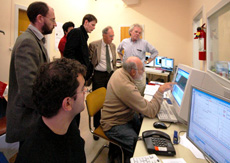Toward a high-intensity
muon source

Impact of a single pulse of 12 x 1012 protons at 14 GeV on a 1cm-wide jet of mercury flowing at 15m/s in a 10T solenoid field: a) at the moment of impact (T=0); b) 9ms after impact; c) 15ms after impact.
To solve the mysteries of nature, physicists operate accelerators that deliver beams of particles including electrons, positrons, protons, neutrons, photons, neutrinos and nuclei. Particle physicists would like to add a muon accelerator to their list.
Results obtained with the Mercury Intense Target experiment show that this might be possible.
Muons are short-lived particles that are 200 times heavier than electrons. Physicists create muons by smashing a beam of protons into a solid or liquid target. The collisions of protons with atomic nuclei produce pions that decay within a fraction of a second to yield muons.
One of the key challenges for building a muon accelerator is the construction of an intense muon source. To be successful, scientists must build a source that consistently produces a large number of muons without destroying the target. They also must develop a strong magnet that channels these pions into a specific direction before they decay.
In November, physicists working on the MERIT experiment successfully tested a muon source concept developed by the DOE-supported Neutrino Factory and Muon Collider Collaboration. The NFMCC collaboration, which includes scientists from 41 institutions, proposed a target that consists of a free-liquid mercury jet flowing at 20m/s within the confines of a 20T solenoid field. The pions are produced by an intense proton beam that hits the jet with a beam spot size of a few millimeters.
The heat deposited in the mercury jet corresponds to the energy emitted by hundreds of 1kW heaters in a space that is 1cm in diameter and 30cm long. Can the jet survive this heat?
Using the Proton Synchrotron at CERN, the Mercury Intense Target collaboration demonstrated that the jet could, in principle, withstand a proton beam of up to 4MW power.

Left to right, seated: Hugo Pereira, CERN; Harold Kirk, BNL.
Left to right, standing: Chris Densham, RAL; HeeJin Park, BNL (obscured);
Peter Loveridge, RAL; Roger Bennett, RAL; and Kirk McDonald, Princeton. Image courtesy of Robert B. Palmer.
Read more
Result of the Week Archive
|